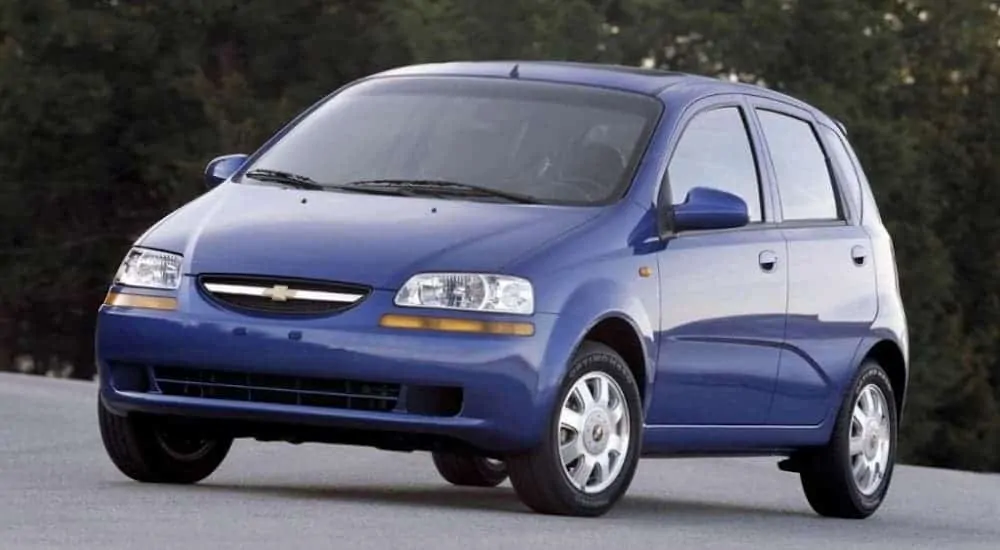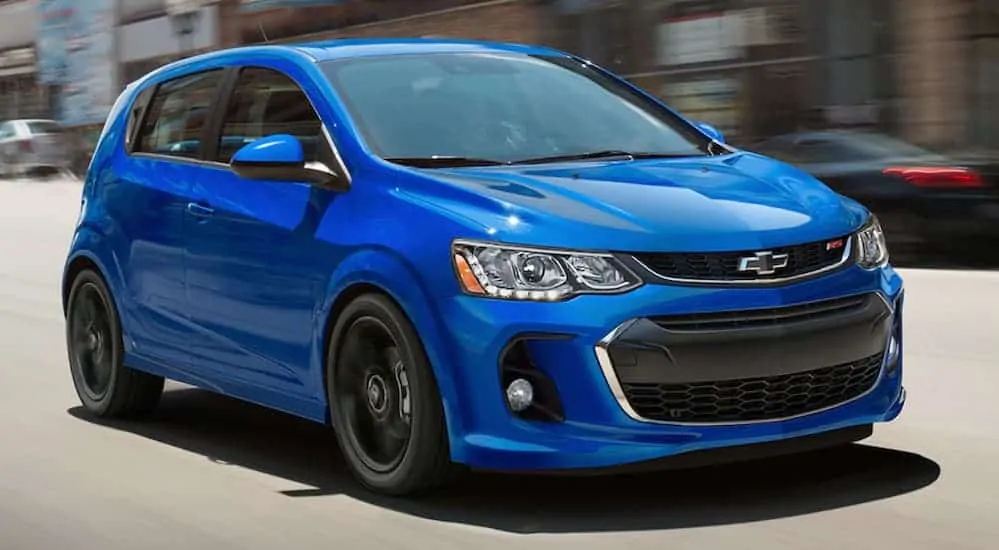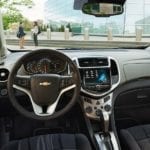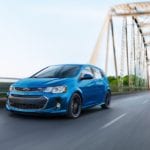What we now know as the Chevy Sonic has gone by a few different names over the years. A subsidiary of General Motors, Daewoo (a.k.a. GM Korea Company) started manufacturing this subcompact vehicle over fifteen years ago, in 2002. It has been sold under seven different brands in 120 countries around the world. Along with Chevrolet in the U.S. and Daewoo in South Korea, Holden, Pontiac, Ravon, and Suzuki have all marketed the vehicle that we call, the Sonic. Here’s how it has transformed through the years into the current futuristic model as the 2020 Chevy Sonic.
First Generation of the Chevy Aveo TD200 & TD250
The first generation of the “Chevy Sonic” was called the Aveo TD200 by most manufacturers. In its home country of South Korea, it was also called the Daewoo Kalos, after the Greek word for “beautiful” or “good.” Due to some financial struggles of Daewoo at the time, the first three years of the TD200 in South Korea was uncertain. It came in a few different styles, a four-door sedan and a five-door hatchback across the board. Eventually, in Europe, a three-door hatchback was also introduced starting in 2005. Despite its subcompact classification, the TD200 used its small space wisely, offering unmatched headroom in its class at the time.
In February of 2003, the Chicago Auto Show introduced the 2004 model of the TD200 to North America. It went on sale in November of 2003 as the five-door and four-door models. A memorable 60-second New Year’s Eve television advertisement showcased the new Aveo driving down the Twin Peaks in San Francisco. It was set to the iconic tune of Steppenworlf’s Magic Carpet Ride. Over the next few years, the TD200 quickly rose to success. By November 2006, it became the largest selling subcompact vehicle in the United States.

After the TD200 came the next version, the TD250. This presented a facelifted hatchback with an updated instrument panel on the sedan. It was introduced at the 2007 Frankfurt Motor Show for intended marketing in North America and Europe. A version in South Korea was called the Gentra X. This version offered a new Ecotech engine featuring a variable valve timing engine. Since 2011, the TD250 has been sold in Brazil under the name, the Chevy Cobalt. As a sedan, it was updated and brought to the Russian market in 2016. This version was called the Ravon Nexia R3. In some form or another, it would be difficult to find a part of the world that doesn’t have a version of the Chevy Sonic on the road.
The Second Generation Introduces the TD300
During the second generation, starting in 2012, the Aveo was renamed the Chevy Sonic. It was previewed at the Paris Motor Show in 2010. GM Korea led the development of this second generation vehicle with collaboration from engineers in the United States (Chevrolet) and Australia (Holden). It was designed by Ondrej Koromhaz from Australia, who intended for it to be styled like a “four-seat motorcycle,” with exposed headlights and a motorcycle-style instrument cluster. In the United States, Corvette Racing engineer John Buttermore was responsible for the Sonic’s superior suspension tuning.
It Australia and New Zealand, Holden sold the TD300 as Holden Barina, but stocks of the Barina ran out in early 2019. The vehicle became sold under the Chevy Sonic nameplate in the United States, Mexico, Canada, Colombia, Argentina, Brazil, Chile, Japan, Israel, the Middle East, South Africa, and ASEAN markets. It continues to be available at a four-door sedan and five-door hatchback style. The four trims available include the 1LS/LS, 1LT/LT, 1LZ/LZT, and RS. Several concept cars were born out of the Sonic, including the Sonic Super 4 race car concept.
It was facelifted again in 2016, with new equipment, updated front fascia, and new LED taillights. Based on other 2016 models, the Chevy Sonic won Most Dependable Small Car from J.D. Power Dependability Award. Aside from North America, the TD300 was widely discontinued internationally as a growing SUV market took over in other parts of the world. For 2020, the manual transmission was dropped in the United States, and several appealing upgrades were introduced. It has taken a while to get to where it is today, but the Chevy Sonic continues to hold strong for American drivers.
Reviews on the 2019 Chevy Sonic
Based on reviews for 2019, the newer Chevy Sonics seem to be doing well. For 2019, the 1.4-liter turbo engine became standard, making this a great car for keeping up with stop-and-go traffic. It came paired with either a standard or automatic six-speed transmission. The remote start was introduced as an option, and several tech features made it an appealing buy for young families. Despite being small and economical on fuel, the Sonic has been noted for its space-efficient interior. Kelley Blue Book rated it a 4.3 out of five. Its suspension and steering system are excellent, providing a smooth ride and quiet interior. Its user-friendly infotainment system comes with a 7-inch touchscreen and Bluetooth for phone and streaming.
Drivers gave the 2019 Sonic a slightly higher rating at 4.4 out of five. Those who purchased the Sonic in 2019 have called it a “good buy for the price,” noting that’s quiet and tech-savvy with good handling. Others say it’s reliable and fun with good engineering and driveability. It has also been said to be reliable with zero mechanical problems or the need to worry about it breaking down. In particular, the Bose Sound System and the heated seats are likable features. Enjoyed by both customers and expert reviewers, it’s clear that the Chevy Sonic is continuing on the road to success. Its past experience both internationally and in the United States has helped refine and shape it with the most appealing features, while also dropping those over time that didn’t prove valuable.
What’s In Store For the 2020 Chevy Sonic
The new Chevy Sonic hatchback starts at an MSRP of $16,720. Its estimated fuel efficiency is 26 miles per gallon in the city and 34 miles per gallon on the highway. The 1.4-liter Ecotech turbocharged engine paired with a six-speed automatic transmission will produce a maximum horsepower of 138. Some of the safety options available include rear park assist, rear vision camera, forward collision alert, and lane departure warning. The Complete Care Package lets you include maintenance, roadside assistance, mechanical warranties, and an Onstar Safety and Security Plan. New Chevys also come with Connected Access, providing Chevrolet Smart Driver and Vehicle Diagnostics for ten years.
The 2020 Sonic provides 47.7 cubic feet of cargo space. Drivers can choose from nine exterior colors, ranging from the more conservative Nightfall Grey Metallic to more vibrant options such as Cajun Red Tintcoat, Cayenne Orange Metallic, and Kinetic Blue Metallic. There’s lots of technology available in the 2020 Sonic, including a built-in 4G LTE WiFi Hotspot. Connect up to seven devices to stream movies, download games, and surf the web on your next road trip, and find a parking spot using ParkWhiz when you get there. Through Marketplace, you can book a hotel and order take-out meals. With several smart features focused on driver convenience, the Chevy Sonic makes for happy drivers and repeat customers.





